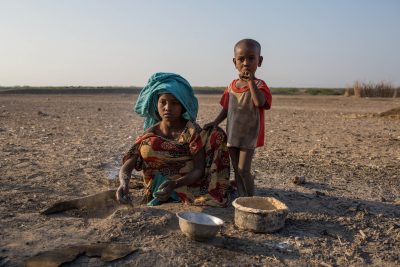UNICEF Ethiopia/2015/Tanya Bindra
By
Alpha Jallow
The Ethiopian Minister of Agriculture, Tefera Derebew, stated that his country has put in place measures to address the occurrence of El Nino which recently affected their country as a result of climate change.
In an interview during the 29th Session of the FAO Regional Conference for Africa held at Abidjan, he stated that Ethiopia has been experiencing a severe drought, in particular in the drought-prone areas of North-East and the Eastern parts of the country where millions of people are in need of food support.
Mr. Tefera Derebew reiterated that the resilience capacity they have built in Ethiopia for the last decade was able to mobilize all the necessary resources and capacities needed to manage the situation. “In this regard, the National Strategic Reserve (NSR) capacity that we have built played a crucial role in actually managing our grain liquidity problem and timely delivery of food to our people, equally distributed,” he explained.
He further stated that the National Strategic Reserve mainly works through basic interests where storage in different parts of the country is well positioned to serve the whole country. So far, Ethiopia has been able to build 450 thousand metric tons capacity and working at taking it to the level of 1.5 million metric tonnes.
The importance of National Strategic Reserve
According to Minister Derebew, the NSR purpose is to reserve the grain and whenever there is an emergency need, the government ministries, agencies and development partners, even the World Food Program, would borrow from the reserve. They would then repay in kind the same quality and amount of grain they previously borrowed.
The second purpose of the National Strategic Reserve is to address price fluctuation in the market and protect the farmer whenever there is a significant fall in price. The strategic reserve would buy from smallholder farmers and when the prices rise, the reserve would release supplies to the market thus helping in controlling prices. ‘It is a kind of stabilizing mechanism and is also a kind of addressing emergency needs,’ he confirmed.
Tackling EI Nino
In tackling the El Nino effect in Ethiopia, this strategic reserve has played a considerable role. ‘We have been able to manage the grain liquidity we borrow from the reserve; we supply it in relatively low logistic costs, timely delivery and right amount per each and every individual’s need. On top of that, we are able to buy from the international market more grain that we store while the available reserves can be used. We make sure this rotation is maintained,’ said Tefera Derebew.
Given the severity of the drought problem and the number of people who are in need of food support, unless we have this capacity, the effect with impact would have been catastrophic. This drought is the most severe one that Ethiopia has faced in 50 years, according to the Minister.
Water Challenges
The Ethiopian authorities are undertaking irrigation activities under smallholder farmers, especially in the lowlands which are pastoral and drought-prone areas. They are also trying to utilize the underground water so that irrigation is possible both for forage and crop production; farming and livelihood systems of the pastoralists would also improve under such intervention. Expanding irrigation has helped the country in tackling the problem and compensating the loss from the main season with irrigation activities in moisture areas.
Way Forward
‘The way forward is for us to prepare ourselves for the worst case scenario, we are buying more grain from the international market, we are storing more grain, and we are procuring from the local market, in particular pulses to make sure that the daily diet requirement is fulfilled. The other issue we have is water both for livestock and people. So, we are aggressively doing infrastructure development, and at the same time, developing underground water for better supplying,’ explained Tefera Derebew.
‘I think we are in the right direction, The main cropping season will run from June to September 2016; so, once we produce, we’ll be able to solve the problem. This will take us up to the end of December 2016,’ he added.




No Comments Yet!
You can be first to comment this post!